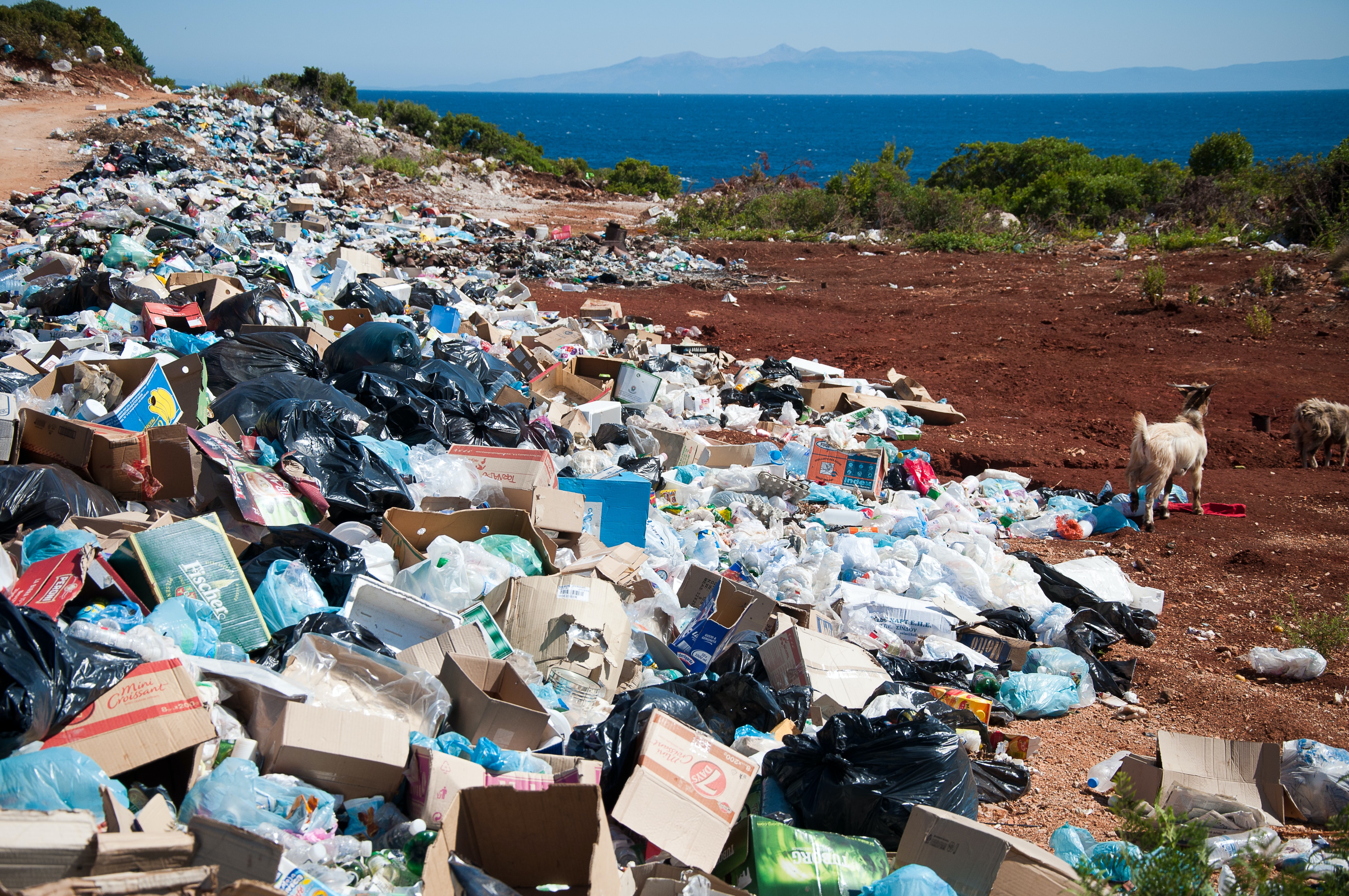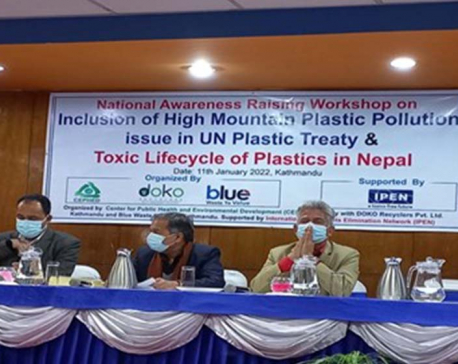
OR
Opinion
The Bleak Legal Regime Addressing Plastic Pollution
Published On: December 29, 2021 06:30 AM NPT By: Roshani Giri

Plastic pollution has touched every aspect of life on earth and has become a problem of the century along with climate change and biodiversity loss. Despite a large number of researches showing the impacts of plastic on marine life and also the amount of plastic humans consume due to contamination of food, the production and use/consumption of plastic largely remains unregulated.
Roshani Giri
Once considered the greatest discovery for the protection of the environment from deforestation for paper packaging and bags, plastic suddenly became the most challenging land-based pollution in less than 100 years. Despite the deeply-embedded use of plastic in each and every aspect of modern life, unlike the regulation and subsequent success of phasing-out of Ozone depleting gases and regulation of Mercury, regulation of plastic is patchy, diverse and more challenging because of its cheapness, availability and penetration into life. The international law regulates plastic as a pollutant that should be prevented from entering the marine life within the cluster of all land-based pollution, and its impact on biodiversity. The regulations specifically address where the plastic ends as a waste, rather than the whole lifecycle of plastic.
This regulation of disposal in various instruments, though is utterly important, is not enough to address the scale and problems of plastic pollution we face today. This is evidently manifested in the fact that despite Nepal being a party to the United Nations Convention on Law of Seas (UNCLOS), no steps have been taken to prevent pollution of rivers as a means to implement the obligations under UNCLOS. Apart from the weak implementation regime, a major lacunae in the current patchy regime of plastic regulation is that the production of plastic remains largely unregulated and thus only provides a partial picture of the plastic pollution and its solution. In fact, sometimes the international instrument itself becomes a part of the problem rather than the solution due to its failure to provide a bigger and clearer picture of regulation and failing to address plastic as an individual substance.
The blanket provision of Article 207 of the UNCLOS includes the obligation of the state parties to adopt laws and regulation to reduce and control plastic, from entering the marine environment. Despite research showing that the majority of the plastic in marine environments comes from a handful of countries, it is almost impossible to find a causal link between the polluter and the pollutant because of which attribution of responsibility becomes difficult. Art. 207 doesn’t provide a picture of what the laws should be, except that they should stem from internationally agreed rules and practices, so actually calls for due diligence obligation of the state.
Similarly, Article 192 of the UNCLOS creates an obligation on the state parties to protect and preserve marine environment. This overarching obligation includes protection of the marine environment from any pollutant. Along with Article 193, these provisions (192 and 193) of UNCLOS create a negative (duty not to introduce plastic pollution in the marine environment) as well as positive obligation (duty to prevent the private actors from introducing pollution in the marine environment) which together form customary international law as stated by the ITLOS in South China Sea Arbitration, and thus binding even on the non-parties to the Convention. The problem of plastic is not limited to the pollution that we can see with naked eyes but penetrates through the microplastic pollution of the marine environment, the consequences of which are yet to be known. In addition to the breaking of plastic in the sea, the microplastic that reaches the marine environment from the use of various cosmetic products including glitters, microplastic beads are also in fact regulated by the UNCLOS’s Art. 207, 192 and 193.
Apart from the plastic which ends up in the marine environment, those which remain on the land also pose a significant pollution problem as they take hundreds of years to decompose and have a devastating impact on biodiversity as well as nature itself. A large number of marine as well as terrestrial beings lose their lives to plastic consumption. So, regulation of plastic not only from entering the marine environment but also those in land is a challenge. The Basel Convention frames a regulation of plastic as a substance (pollutant) rather than its location. Through a recent amendment, it has included plastic waste (though under non-hazardous list) within its regulation and prior informed consent system which requires prior informed consent from the state receiving the plastic waste for recycling. Though the Convention has listed plastic as a non-hazardous substance, the regime of environmentally sound disposal is of particular importance both to ensure that the plastic waste doesn’t end up in a discarded landfill or dumping in the sea. Basel Convention’s principle of minimization of waste, proximity of disposal and absolute prohibition on sending wastes to some places is crucial in regulating the plastic waste disposal.
Plastic pollution has touched every aspect of life on earth and has become a problem of the century along with climate change and biodiversity loss. Despite a large number of researches showing the impacts of plastic on marine life and also the amount of plastic humans consume due to contamination of food, the production and use/consumption of plastic largely remains unregulated. This leaves a weak regime of plastic regulation limited to its movement and disposal. As a matter of fact, regulation of the entire life of plastic is no more a matter of precaution as the impact of plastic on environment, biodiversity and human health is supported by scientific research, but one of prevention.
However, the lack of an umbrella legal regime that governs the overall life cycle of plastic in a way to phase-out certain plastic production and consumption is a missing link between the existing legal instruments regulating plastic in terms of their location and the regulation of plastic as a substance whose entire life cycle needs to be regulated by the law. Elizabeth Kirk and Naporn Popattanachai’s argument on a treaty to regulate and in fact phase out of oil-based plastic would initiate a regulation of plastic production and supplement the existing ((though bleak) management of already produced plastic. So unless we regulate plastic at source along with possible alternatives in the approach taken by the Convention on depletion of Ozone layer targeting the production and consumption of ozone depleting sources, despite the problem being acknowledged and addressed through existing international instruments, the result will remain bleak.
Plastic pollution as we see it today needs a much more dedicated regime for us to be truly able to address it. Neither the laws and courts (domestic or international) alone nor the activists spending their lives on this can fix this problem as long as we do not address the accountability of manufacturers who profit from the massive production of plastic and leave it to the consumers and government to deal with it as a waste. However, such an approach is unsustainable and inadequate to really address the large problem at hand. Therefore, the law, courts as well as all the related stakeholders need to focus on making the production of plastic more accountable to the environment if we are truly willing to solve this problem together.
You May Like This

Experts concerned over increase in plastic waste in Himalayan region
KATHMANDU, Jan 12: Experts have shown concerns over the increase of microplastics in the snow and water sources in the... Read More...

Mountain matters
It is getting too late to mainstream mountain communities in the initiative to fight impacts of climate change ... Read More...

With rising sea levels, Bangkok struggles to stay afloat
BANGKOK, Sept 2: As Bangkok prepares to host climate-change talks, the sprawling city of more than 10 million is itself... Read More...

Just In
- Sajha Yatayat cancels CEO appointment process for lack of candidates
- Govt padlocks Nepal Scouts’ property illegally occupied by NC lawmaker Deepak Khadka
- FWEAN meets with President Paudel to solicit support for women entrepreneurship
- Koshi provincial assembly passes resolution motion calling for special session by majority votes
- Court extends detention of Dipesh Pun after his failure to submit bail amount
- G Motors unveils Skywell Premium Luxury EV SUV with 620 km range
- Speaker Ghimire administers oath of office and Secrecy to JSP lawmaker Khan
- In Pictures: Families of Nepalis in Russian Army begin hunger strike
















_20240419161455.jpg)

Leave A Comment